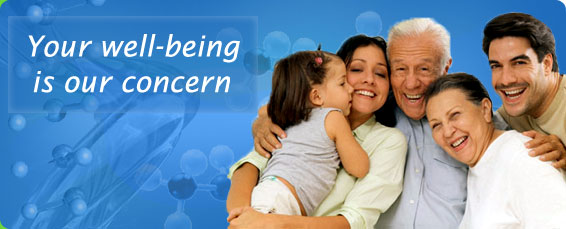Click here for information on swine flu.
Health Topics
Osteoporosis
This is a condition that occurs when the bones decrease in mass and strength due to a reduction in the mineral content of the bones. New bone is continuously added to the skeleton and old bone is taken away. This is normally regulated so that healthy bone mass is maintained but in osteoporosis the rate of breakdown is greater than the rate of formation.
Maximum bone mass is reached in the mid twenties and begins to decease after the mid thirties. The outer shell of the bones becomes weaker and holes develop in the inner material. Age related osteoporosis is the most common cause of decreased done density.
Oestrogen deficiency, which affects many post-menopausal women, is a major cause of accelerated bone loss. Age-related testosterone deficiency in men is also associated with the development of Osteoporosis. The effects of these deficiencies are exacerbated by low calcium levels in the body. When the bones are fragile, there is an increased risk of fracture, particularly in the hip, spine and wrist and many cases of osteoporosis are not detected until there is a fracture. There may be no symptoms in osteoporosis but sometimes there is pain in bones or muscles, especially in the back. The condition can be either primary or secondary. Primary osteoporosis is age related and secondary is caused by surgical removal of a young woman’s ovaries or by some medications such as loop diuretics, corticosteroids and anti-convulsants.
There is no cure for osteoporosis but it can be prevented. Adequate supplies of calcium and vitamin D either in the diet or by supplementation are vital. Dairy foods, tinned salmon and sardines, dried beans and broccoli are all foods rich in calcium. Cod liver oil, fatty fish and fortified cereals all contain vitamin D. Phyto-oestrogens have an oestrogenic effect on the bones and can be consumed by women to prevent osteoporosis. Flaxseed and soya protein are also excellent sources of phyto-oestrogens. Regular weight-bearing exercise that helps improve balance, co-ordination and muscle strength also has a preventative effect. Walking, swimming and Tai Chi are good examples of such exercise.
Age is not the only risk factor associated with osteoporosis. Other predisposing factors are gender (women are more likely to develop the condition), high alcohol intake, smoking, poor diet, lack of exercise, stroke, hyperthyroidism, prolonged bed rest and excessive intake of salt and caffeine.
Osteoporosis is usually diagnosed with a test called a bone density test. In most cases treatment will include lifestyle changes such as dietary modification and exercise. Supplements may be required and the Doctor may prescribe medication such as bisphosphonates, calcitriol or medications that restore oestrogen and progesterone levels.
Further information and support is available from the Irish Osteoporosis Society on 01-8258159; e-mail: Crowley@gofree.indigo.ie
Show all
This is a condition that occurs when the bones decrease in mass and strength due to a reduction in the mineral content of the bones. New bone is continuously added to the skeleton and old bone is taken away. This is normally regulated so that healthy bone mass is maintained but in osteoporosis the rate of breakdown is greater than the rate of formation.
Maximum bone mass is reached in the mid twenties and begins to decease after the mid thirties. The outer shell of the bones becomes weaker and holes develop in the inner material. Age related osteoporosis is the most common cause of decreased done density.
Oestrogen deficiency, which affects many post-menopausal women, is a major cause of accelerated bone loss. Age-related testosterone deficiency in men is also associated with the development of Osteoporosis. The effects of these deficiencies are exacerbated by low calcium levels in the body. When the bones are fragile, there is an increased risk of fracture, particularly in the hip, spine and wrist and many cases of osteoporosis are not detected until there is a fracture. There may be no symptoms in osteoporosis but sometimes there is pain in bones or muscles, especially in the back. The condition can be either primary or secondary. Primary osteoporosis is age related and secondary is caused by surgical removal of a young woman’s ovaries or by some medications such as loop diuretics, corticosteroids and anti-convulsants.
There is no cure for osteoporosis but it can be prevented. Adequate supplies of calcium and vitamin D either in the diet or by supplementation are vital. Dairy foods, tinned salmon and sardines, dried beans and broccoli are all foods rich in calcium. Cod liver oil, fatty fish and fortified cereals all contain vitamin D. Phyto-oestrogens have an oestrogenic effect on the bones and can be consumed by women to prevent osteoporosis. Flaxseed and soya protein are also excellent sources of phyto-oestrogens. Regular weight-bearing exercise that helps improve balance, co-ordination and muscle strength also has a preventative effect. Walking, swimming and Tai Chi are good examples of such exercise.
Age is not the only risk factor associated with osteoporosis. Other predisposing factors are gender (women are more likely to develop the condition), high alcohol intake, smoking, poor diet, lack of exercise, stroke, hyperthyroidism, prolonged bed rest and excessive intake of salt and caffeine.
Osteoporosis is usually diagnosed with a test called a bone density test. In most cases treatment will include lifestyle changes such as dietary modification and exercise. Supplements may be required and the Doctor may prescribe medication such as bisphosphonates, calcitriol or medications that restore oestrogen and progesterone levels.
Further information and support is available from the Irish Osteoporosis Society on 01-8258159; e-mail: Crowley@gofree.indigo.ie
Show all







